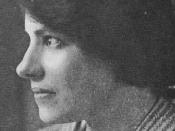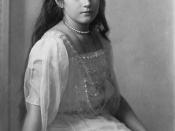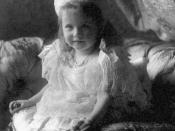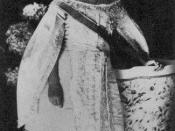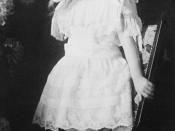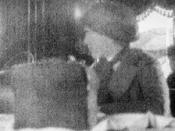Anastasia Romanov was the youngest daughter of Czar Nicholas II, the last Czar of Russia, and his wife Alexandra. She was born June 18th, 1901, and grew up during one of the most tumultuous times in Russian History. During the second Russian Revolution, the Bolsheviks assassinated her parents and three sisters on July 16th, 1918. This marked the end of the three hundred year rule by the Romanov family over Russia. Although Anastasia and her younger brother were present during the shootings, their deaths were never confirmed. There has been much speculation of the fate of the two siblings, particularly Anastasia who has become a legendary figure. There are three main theories: 1. She died with her family, 2. She escaped and was never found, 3. She is one of the people claiming to be her. Even though there is no definitive evidence for any of these theories, the most popular theory is that Anastasia survived and reappeared as Anna Anderson.
Because of the credibility of her story, physical similarities, relatives' affirmations, and objective evidence/sources, many people believe Anna Anderson was Anastasia.
Anna Anderson was also known by many other different names. She first appeared on February 17,1920 in Berlin after she had jumped off a bridge trying to commit suicide. A policeman found her and brought her to the hospital. She was diagnosed as an amnesiac and was categorized as Fraulein Unbekannt (Miss Unknown). One of the patients at the hospital noticed her resemblance to Anastasia and brought it to the attention of a nurse. When they showed her pictures of the Russian royal family, she declared herself as the Grand Duchess Anastasia. She was also named Mrs. Alexander Tschaikovsky, because Alexander Tschaikovsky was the man who saved Anastasia from the assassination that night. Anna claimed that she ran off with him to Romania and they got married. Anna was also known as Anastasia Manahan since she married a wealthy American, John Manahan in 1969.
Creed-2 Anna Anderson described her escape from the assassination so well, that there were no doubts among a lot of people that Anna was Anastasia. She explained that she survived the shooting due to the diamonds that she had hidden in her shirt. When the Bolsheviks barged into the cellar and started shooting, the bullets deflected off her diamonds since the jewelry in her shirt acted like a bulletproof vest. As the bullets deflected off her, the Bolsheviks thought she was a God because she didn't die. Instead they stopped shooting and started stabbing her with their bayonets. Anastasia finally fell to the ground; the Bolsheviks thought she was dead. However, their bayonets were so dull, she survived. Consequently the soldiers left. "A Russian soldier named Alexander Tschaikovsky saw Anastasia still moving"ÃÂ(Grand Duchess Anastasia). During the chaos of that night he rescued her"ÃÂ(Grand Duchess Anastasia). Tschaikovsky and Anna ran away to Romania together. There they got married and had a baby boy. Shortly afterward, Tschaikovsky died and Anna decided to put the baby into an orphanage. "She had no place to stay, so she decided to walk to her aunt, Princess Irene's palace in Berlin"ÃÂ(Grand Duchess Anastasia). "When she reached her aunt's palace, she was afraid that no one would recognize her, so she chose to commit suicide by jumping off a bridge"ÃÂ(Grand Duchess Anastasia). Her story seemed so believable, that few doubted her.
Furthermore, Anna Anderson and Anastasia had many physical similarities. Both of them were very petite, standing in at five foot and two inches and weighing a mere 105 pounds. Dr. Moritz Frahtumyr, found that Anna's ear and Anastasia's ear had seventeen anatomical points, five more than needed for identification. Anna had blue eyes with dark blonde hair, as did Anastasia. Also, Anna had scars on her body in the same places as Anastasia. Anna had a scar on her middle finger from when Anastasia got her finger slammed in the carriage door. Anna also had a scar on her forehead that was similar Creed-3 to one that Anastasia had because of a fall. Anna also had other scars on her chest that she said were from being bayoneted and shot. However, her detractors claimed that Anna's scars were from a grenade in a munitions factory while Anna was working. Another physical similarity was their feet. They both were afflicted with a similar foot deformity called hallux vulgus. "This is when the large toe turns inwards towards the other toes on the same foot creating a bunion"ÃÂ(Anastasia info). Anna's right foot was more severe as was Anastasia's. Dr. Otto Reche, an anthropologist, "compared their faces millimeter by millimeter."ÃÂ(Massie 190) He hypothesized that Anna and Anastasia were either identical twins or the same person.
Moreover, there was substantial objective evidence/sources that supported that Anna Anderson was Anastasia. "During the Hamburg trials, the court decided to obtain physical evidence, based on science"ÃÂ(Massie 190). The court hired Dr. Otto Reche, an internationally famous anthropologist and criminologist and Dr Minna Becker, a graphologist. "Reche composed more than hundred pictures of Anastasia and took picture's of Anna Anderson under the same lighting and at the same angles"ÃÂ(Massie 190). He compared the two faces very carefully, concluding that no two faces are so similar except if they are identical twins or the same person. Reche said, "Mrs. Anderson is no one else than Grand Duchess Anastasia"ÃÂ(Massie 190). Dr. Becker compared handwriting samples of Anna and Anastasia. "I have never before seen two sets of handwriting bearing all these concordant signs which belonged to two different people"ÃÂ(Massie 190). "I am ready to state on my oath and on my honor that Mrs. Anderson and Grand Duchess Anastasia are identical"ÃÂ(Massie 190). Another objective source Anna used was the "P.I.K. method, which had been accepted in criminal cases by German courts"ÃÂ(Massie 191). Dr Moritz Frutmayr "proved that the anatomical points and tissue formations of Anna Anderson's Creed-4 right ear corresponded with Grand Duchess Anastasia's right ear in seventeen points, five more than the twelve required by German courts to establish identity"ÃÂ(Massie 191).
In addition, many of Anastasia's family and friends believed that Anna Anderson was Anastasia. However, there were some non-believer's. Princess Irene, her aunt, met Anna and stated that Anna didn't remind her of Anastasia. However, after the meeting she cried, "She is similar, she is similar."ÃÂ(Krug Von Nidda 155) Anna also won over Princess Irene's son, Prince Sigismund, who was a childhood friend of Anastasia. To see if Anna was Anastasia, he asked Anna several questions about their childhood. Her answers to the questions persuaded him that she was Anastasia. Anna met with another one of her aunts, Grand Duchess Olga. Initially, she wasn't sure if Anna was Anastasia or not, but finally determined that Anderson wasn't Anastasia. Anastasia's tutor, Pierre Gilliard, met Anderson and considered she might be Anastasia. However, in their last meeting together he too denied her resemblance and "called her a first rate actress."ÃÂ(My name is Anastasia) Another believer was Mathilde Kschessinka, Nicholas' mistress before his marriage. When she glanced into her eyes she noticed that Anna had Nicholas' eyes, and looked at her with "the emperor's look."ÃÂ(Grand Duchess Anastasia) Also Nicholas' cousin, Mathilde Kschessinka's husband, Grand Duke Alexander became a believer. While spending two days with Anderson, he exclaimed, "I have seen Nicky's daughter, I have seen Nicky's daughter!"ÃÂ(Grand Duchess Anastasia) Additional supporters included Anastasia's cousin Princess Xenia, and childhood friends Gleb, Sergei, and Tatiana Botkin. When Anastasia and Gleb were younger, he would draw animals, which delighted Anastasia. As soon as Gleb and Anderson met, she asked him about his "funny animals"ÃÂ, which immediately convinced Gleb Anna was Anastasia. Sergei quoted, "Mrs. Tchaikovsky is either Grand Duchess Anastasia or a miracle"ÃÂ.(Massie 164) Anna Anderson claimed that "her"ÃÂ uncle, Creed-5 Grand Duke Ernst of Hesse, made a visit to Russia in 1916, when his country was at war with Russia. "Ernst angrily denied making the visit, but the Kaiser's stepson testified in court in 1966 that he had been told Ernst did secretly make the trip."ÃÂ(Maurette 112) No one could have told Anna about his visit because the family Ernst visited had died in the cellar, so how could she know about this? Despite the longest court case in German history, Anna was neither proved to be Anastasia nor proved not to be. During the early 1990's, "DNA testing of her hair and tissue samples concluded that she was not Anastasia, but Franziska Schanzkowska, a young polish girl"ÃÂ(Grand Duchess Anastasia). However, many felt that since all the parties involved in the comparison were dead that no one could be sure that these tests were accurate. With the social turmoil created by the Russian Revolution and the two world wars, the search for the truth was a difficult process. She led a sheltered life as a child in the royal family seen by only close friends and family. Also, the physical and psychological changes that would have occurred as a result of surviving the vicious assassination attempt makes identification more difficult. Moreover, there was a lack of medical records and other physical evidence like fingerprints and DNA to prove or refute that Anna Anderson was Anastasia. Also, the size of the Romanov family fortune that Anastasia would be entitled compromised the objectivity of family members. Despite these challenges there is still strong support for the contention that Anna Anderson was the one and only Anastasia.
